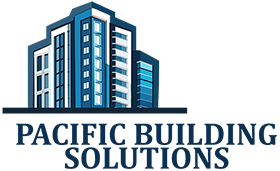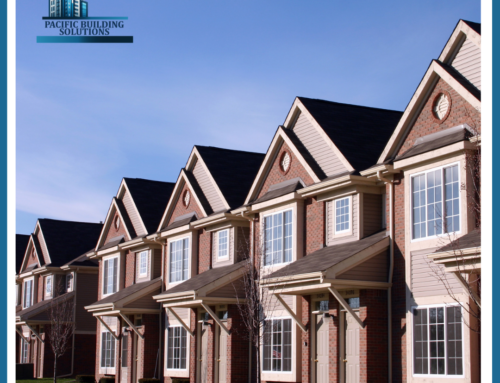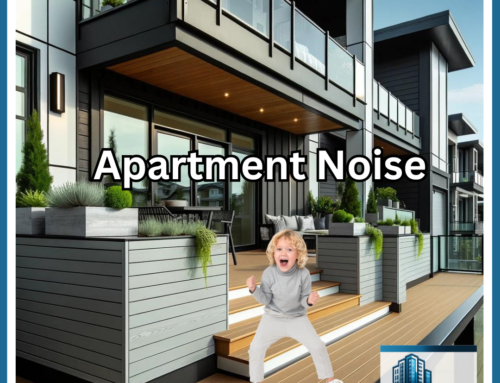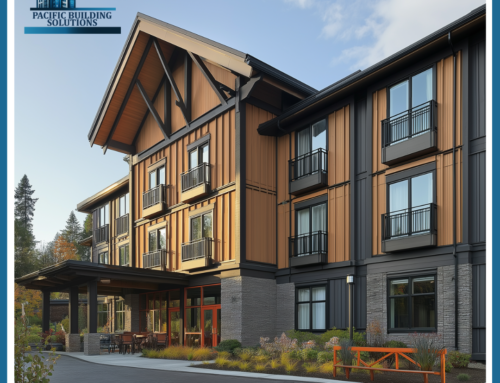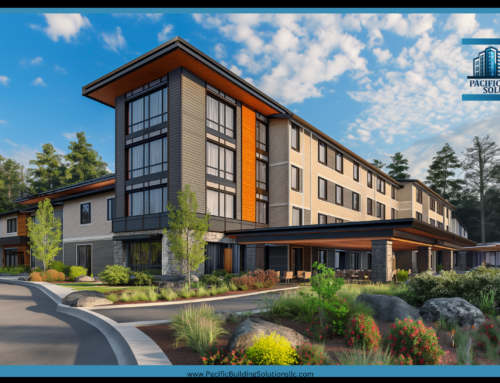
Maintaining Multifamily Properties
Managing the upkeep of an apartment building or condo complex can be a complex balancing act. As these buildings age, critical elements like windows and roofing begin to show their wear, which affects not only the building’s energy efficiency but also its curb appeal and safety. Property managers and building owners often face the dilemma: should they retrofit the aging components or invest in a full replacement?
At Pacific Building Solutions, we know that every building has its unique set of challenges. This guide is crafted to help property managers and owners make informed decisions about balancing cost, durability, and aesthetics for multifamily structures.
Retrofit vs. Replacement: What’s the Difference?
When managing multifamily buildings, it’s essential to understand the core differences between retrofitting and replacing. Each option addresses aging infrastructure in distinct ways, especially for complex structures like apartment and condo buildings.
- Retrofit: This involves enhancing or upgrading the existing structure rather than removing it. For windows, this could mean adding energy-efficient glass or updating the insulation in the current frames. With roofing, retrofitting might involve applying new layers over the existing roof, boosting protection without removing the old material.
Retrofitting is often more budget-friendly upfront, making it a popular choice for property managers who must address issues quickly and with minimal disruption to tenants. Because the original materials remain, retrofits tend to be less invasive and faster to complete. For example, retrofitting windows allows you to preserve the building’s look while improving energy performance without the extensive labor involved in pulling out frames. Likewise, retrofitting reduces roofing waste, as the old roof isn’t torn off and requires fewer materials.
However, retrofitting is most effective when the underlying structure remains in good condition. Retrofitting may offer only a temporary solution if there are deeper problems, such as extensive leaks, rotting, or structural weaknesses.
- Replacement: In contrast, replacement involves fully removing the outdated material—windows, roofing, or insulation—and installing brand-new systems. This option is more expensive and time-consuming, but it typically results in the most significant improvements in performance and longevity. Replacement is a better option for multifamily buildings facing major issues like failing window frames, severe leaks, or compromised roofing integrity.
Replacing windows can dramatically improve energy efficiency, soundproofing, and even security. Similarly, a full roof replacement ensures that your building is protected from the elements with the latest roofing technology, including options like reflective materials that help reduce energy costs. While the upfront costs are higher, replacements often pay off over time in terms of lower maintenance costs, fewer future repairs, and long-term energy savings.
While retrofitting offers a cost-effective and minimally disruptive solution, it’s typically best suited for properties with well-maintained structures. Replacement, while more involved, offers the best long-term performance and value for buildings with serious issues or a need for more comprehensive updates.
Window Decisions: Retrofit or Replace?
Windows are essential for energy efficiency, ventilation, and natural light. In multifamily units, poorly performing windows can lead to significant heating and cooling costs, unhappy tenants, and even higher vacancy rates. Choosing between retrofitting and replacing them is a crucial decision.
When to Retrofit Windows in a Condo
Retrofitting is often the best choice when window frames are still solid, but the glazing or insulation needs an upgrade. This approach allows you to preserve the original architecture while boosting performance.
Benefits of Retrofits:
- Cost-effective: Less expensive than full replacements since the structure remains.
- Quick to install: Minimal disruptions to tenants.
- Aesthetic preservation: Ideal for buildings with historical significance.
Best for:
- Well-maintained frames needing energy improvements
- Condos where architectural consistency is a priority
- Limited budgets but a need for better insulation
When to Replace Apartment Windows
Full replacement becomes necessary when window frames are warped, rotting, or have extensive damage. For older apartment buildings with outdated or damaged windows, replacement is often necessary to improve energy efficiency and tenant satisfaction.
Advantages of Replacement:
- Better insulation: New materials can drastically reduce heat loss and gain.
- Improved security: Modern windows offer enhanced locking mechanisms.
- Long-term value: Increases the building’s overall value and tenant appeal.
Best for:
- Buildings with aging damaged windows
- Projects where energy savings are a priority
- Improving tenant comfort and satisfaction
Roofing Considerations for Multifamily Units
Like windows, the roof maintains a building’s energy efficiency and structural integrity. Over time, roofs wear out, leading to leaks, poor insulation, and costly repairs. The question is whether to retrofit the existing roof or replace it entirely.
Retrofit Roofing for Apartment Buildings
Retrofitting a roof involves adding new layers of material over the old roofing system. This is often quicker and more affordable than replacement and can extend the life of the existing roof.
Benefits of Roofing Retrofits:
- Lower costs: This avoids the expense of tearing off the old roof.
- Faster process: Reduces disruptions for tenants.
- Additional insulation: Improves energy efficiency, which is a bonus in large buildings with high heating and cooling demands.
Best for:
- Structurally sound roofs that need a refresh
- Buildings with limited renovation budgets
- Projects that need to be completed quickly
When to Opt for Roof Replacement
In cases where roofs are beyond repair—suffering from leaks, mold, or structural issues—a complete replacement is the safer and more durable choice. A new roof provides better protection, energy efficiency, and longevity.
Advantages of Replacing the Roof:
- Durability: A completely new roof will last decades, providing peace of mind.
- Improved energy efficiency: Modern roofing materials often reflect heat, reducing cooling costs in summer.
- Increased property value: A new roof can be a strong selling point or draw for potential tenants.
Best for:
- Buildings with significant roofing damage or leaks
- Projects requiring long-term, durable solutions
- Properties undergoing major renovations
Budget Considerations in Multifamily Buildings
Both retrofitting and replacing come with their costs, but it’s essential to consider not just the upfront expenses but the long-term value. Retrofitting might save money initially, but you could face higher maintenance costs over time if the repairs don’t hold up. On the other hand, a full replacement may require a larger upfront investment but often results in long-term savings on maintenance and energy bills.
Pacific Building Solutions helps clients navigate these decisions by assessing the condition of their building and offering a customized plan that balances immediate needs with long-term financial benefits.
Energy Efficiency for Large Properties
In large apartment or condo buildings, energy efficiency is a top concern. Both retrofitting and replacing windows and roofing materials can drastically reduce energy costs. However, full replacements generally offer the most significant improvements.
For instance, replacing old single-pane windows with modern double or triple-pane windows can reduce heat loss by up to 50%. Likewise, cool roofing materials can reflect sunlight, keeping the building cooler in the summer and reducing reliance on air conditioning.
Aesthetic Integrity of Apartments and Condos
A building’s appearance is crucial for both tenant satisfaction and property value. Retrofitting often preserves the building’s original design, making it an appealing choice for historic or architecturally significant properties. However, even with full replacements, modern materials come in various styles that match or enhance the existing look.
Pacific Building Solutions works with property managers to ensure that any upgrades maintain or improve the building’s aesthetic while maximizing performance.
FAQs
1. Is retrofitting always cheaper than replacement? Yes, in the short term, but it depends on the condition of the building. If the structure is significantly damaged, retrofitting may not be sufficient.
2. How long does a retrofit last? A well-done retrofit can extend the lifespan of your windows or roof by 10-20 years, depending on the materials used and the original condition.
3. Can I retrofit an apartment building without disturbing tenants? Retrofitting is generally less invasive than a full replacement and can be done with minimal disruption.
4. What are the energy savings from replacing windows? Replacing single-pane windows with modern double—or triple-pane options can cut energy costs by up to 30%.
Oregon Zip Codes Served:
Multnomah County
97019 (Corbett)
97024 (Fairview)
97030 (Gresham)
97080 (Gresham)
97201 (Portland)
97202 (Portland)
97203 (Portland)
97204 (Portland)
97205 (Portland)
Washington County
97006 (Aloha)
97007 (Aloha)
97106 (Banks)
97008 (Beaverton)
97005 (Beaverton)
97229 (Bethany)
97109 (Buxton)
97113 (Cornelius)
97116 (Forest Grove)
97117 (Gales Creek)
97119 (Gaston)
97123 (Hillsboro)
97124 (Hillsboro)
97125 (Manning)
97133 (North Plains)
97140 (Sherwood)
97223 (Tigard)
97224 (Tigard)
97144 (Timber)
97062 (Tualatin)
97225 (West Haven-Sylvan)
Clackamas County
97004 (Beavercreek)
97009 (Boring)
97013 (Canby)
97015 (Clackamas)
97017 (Colton)
97089 (Damascus)
97022 (Eagle Creek)
97023 (Estacada)
97027 (Gladstone)
97028 (Government Camp)
97086 (Happy Valley)
97034 (Lake Oswego)
97035 (Lake Oswego)
97222 (Milwaukie)
97038 (Molalla)
97067 (Mount Hood Village)
97011 (Mount Hood Village)
97049 (Mount Hood Village)
97042 (Mulino)
97267 (Oak Grove)
97045 (Oregon City)
97055 (Sandy)
97068 (West Linn)
97070 (Wilsonville)
Marion County
97325 (Aumsville)
97002 (Aurora)
97342 (Detroit)
97020 (Donald)
97317 (Four Corners)
97346 (Gates)
97026 (Gervais)
97305 (Hayesville)
97032 (Hubbard)
97350 (Idanha)
97352 (Jefferson)
97303 (Keizer)
97384 (Mehama)
97362 (Mount Angel)
97373 (Saint Benedict)
97137 (Saint Paul)
97301 (Salem)
97302 (Salem)
97306 (Salem)
97375 (Scotts Mills)
97381 (Silverton)
97383 (Stayton)
97385 (Sublimity)
97392 (Turner)
97071 (Woodburn)
Columbia County
97016 (Clatskanie)
97018 (Columbia City)
97054 (Deer Island)
97048 (Rainier)
97056 (Scappoose)
97051 (St. Helens)
97064 (Vernonia)
97053 (Warren)
Yamhill County
97101 (Amity)
97111 (Carlton)
97114 (Dayton)
97115 (Dundee)
97127 (Lafayette)
97128 (McMinnville)
97132 (Newberg)
97378 (Sheridan)
97396 (Willamina)
97148 (Yamhill)
